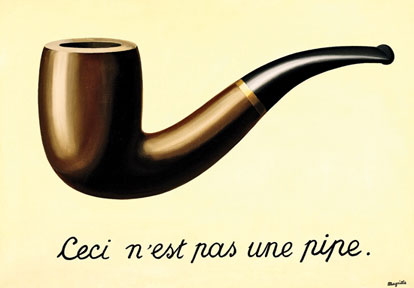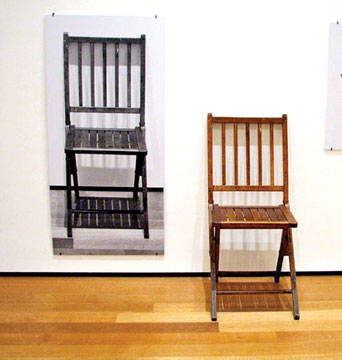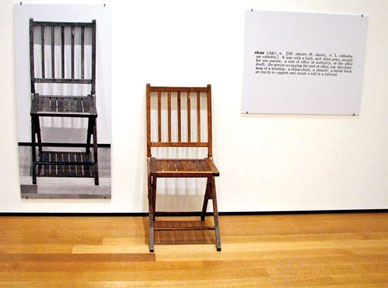|
Prosthetics of imagination:
Theory and cultural practice
By M. Ramachandran
“In the beginning was the Word, and the Word was with God, and the
Word was God. The same was in the beginning with God. All things were
made by him; and without him was not anything made that was made. In him
was life; and the life was the light of men. And the light shineth in
darkness; and the darkness comprehended it not”.
 The quotation is from the Book of John of the King James Version of
The Holy Bible. What does that mean? Does the Word mean promise as the
way we use it now? Or does it mean the word is supreme, life and light?
The arbitrary nature or the relationship between word and meaning, or
between signifier and signified is a much analysed and theorised subject
in the fields of semantics and semiotics by the scholars like Ferdinand
de Saussure and Roland Barthes. The quotation is from the Book of John of the King James Version of
The Holy Bible. What does that mean? Does the Word mean promise as the
way we use it now? Or does it mean the word is supreme, life and light?
The arbitrary nature or the relationship between word and meaning, or
between signifier and signified is a much analysed and theorised subject
in the fields of semantics and semiotics by the scholars like Ferdinand
de Saussure and Roland Barthes.
In the binary division of word and meaning, primacy is given to word
as if it dictates meaning. But meanings are evolved thorough the
relationships among words, the situations, the cultural specificities of
the person or persons and the way they use words and the traces of
history a word carries through in its traverse across cultures.
When we realise the relationship between the medium (the signifier)
and message (the signified) do not have any strong bondage as
conventionally thought of, (from the ancient times to that of Kalidasa
and to the Modernists of the 20th century) and they continually break
apart and reattach in new combinations, we also become aware of that
whatever we write or speak conveys meanings we do not or could not
possibly intend. And our words cannot say what we mean. The authority of
a text on meaning thus becomes a myth. The perpetual interweaving of
texts and meaning is beyond our control. The awareness of the potential
of irrepressible significations of words or signs necessitated the shift
of focus in art and literature from author-centric to a reader centric
one. Once out in the public domain, a piece of literature is liable to
interpretations the author cannot defy. The work of art becomes, if I
use the term coined by Mikhail Bakhtin, carnivalesque by the
participation of people of all shades and colours in it. Bakhtin saw
medieval carnivals as a period of time in which people were able to
ridicule their governing bodies. This ridicule promoted both
freethinking and new ideas in the minds of the public. He then applied
this idea to certain forms of literature, calling them carnivalesque.
Interpretation
An interpretation, in other words the meta-text that produced as a
narrative for communicative action, is an exercise to bring out more
clarity, bring more light upon the basic text. Taking a cue from the
logical correlation with the Word and God from The Holy Bible that I
quoted above, my use of the metaphor light in this context elucidates
the problems of interpretation.
In one’s perception of a visual image, light and shade plays the role
of defining the contours. In other words, light and shade are what
determine the form of the image. That means, the very idea of the
signifier is given by light and shade.
 The more light falls on an image, the less will be its clarity.
Signs, due to their inherent carnivalesque nature i.e., not controlled
by the hegemony and free to express and celebrate their own opinions,
allow polyphony of meanings in all our efforts at metatextuality. Hence,
all interpretations are some kind of misinterpretations. How
convincingly one can interpret, is what makes any interpretation
significant. The more light falls on an image, the less will be its clarity.
Signs, due to their inherent carnivalesque nature i.e., not controlled
by the hegemony and free to express and celebrate their own opinions,
allow polyphony of meanings in all our efforts at metatextuality. Hence,
all interpretations are some kind of misinterpretations. How
convincingly one can interpret, is what makes any interpretation
significant.
Criticism, whether it is art, literary or music, being analytical and
intertextual rather than interpretational it is dynamically discursive.
Hypothetical presupposition is what makes criticism interactive with the
text in which it intervenes to expand the contours of meaning.
Intervention
Such an intervention into the semantic structures of a text converts
it as a discourse material. Distanced from the authoritative control of
the meanings by the author the text is liberated by the application of
critical theory. Critical theory provides the normative bases for all
the analytical tools that are used for increasing freedom in all domains
of society including that of art and culture.
The emergence of the notions of feminism, multiculturalism, minority
and gay/lesbian rights or environmentalism, in the present social
context, is the result of such recognition of intertextuality and
polyphonic nature of language.
In application critical theory, which I consider as an inclusive term
of all critical ideas though it was mainly propagated by the Frankfurt
School and Jurgen Habermas, makes the text upon it works, bare of its
ideology: the explicit enunciated content of the text and its pragmatic
presuppositions.
Analysis
However, in such a discourse analysis that has been taking place with
convincing points of view; say Marxian, Freudian or Deconstructive for
that matter, a tendency of reductionism prevails. Of course, such a
reductionism is unavoidable to the loyal followers of any system of
thought because, beneath such “ideologies” lies some kind of
fundamentalism that distorts the presuppositions of any text.
For many schools of criticism the dominant standpoint of the
philosophy that it tries to follow works as prosthetics of imagination.
Hence, critical theory itself is bound to enunciate its own
presuppositions while working on other texts for their own emancipation.
While the guiding philosophical approach elucidates many a subtext
that naturalises the symbolic order of social relations it also obscures
most of the tendencies of the text to liberate itself from the
analytical eye with its dominating gaze. Resigning from its occupation
in pathology, criticism becomes responsive to the subtleties as well as
the sublime by accommodating all the otherness such as sensibilities,
features and contradictions of attitudes within every textual discourse
whether it is literature or art. Escaped from the clutches of a
domineering point of view the practice of criticism can sympathise with
the social attitudes and conventions that structure many a text. Such an
enlightenment allows the objective of discourse analysis be more
democratic and receptive. It also allows the crossover of boundaries
within the philosophic traditions enabling much more liberation in
social systems and attitudes.
 Certainly positing such an open-ended theoretical propagation for
critical approach is not a relativist or pragmatist one as criticism
does not look for absolutes. On the other hand, such an open-ended
position allows one to comprehend the facets of arguments in the text
not to be distorted by the domination of gaze. Certainly positing such an open-ended theoretical propagation for
critical approach is not a relativist or pragmatist one as criticism
does not look for absolutes. On the other hand, such an open-ended
position allows one to comprehend the facets of arguments in the text
not to be distorted by the domination of gaze.
Power
At the same time, the inevitable hypothetical presuppositions should
not be overlooked in one’s efforts at discarding its domineering power.
It is the ability to be dynamically discursive makes criticism the
strongest binding factor in a multilingual, multicultural and
multiracial society. Ultimately, the simple concern for the other
enables society as well as criticism mutually responsive.
I can foresee the criticism about this position as anarchic. The
notions of blurring the boundaries of philosophical streams and the
proposition to liberate the tool of criticism from the hold of the
guiding point of view to accommodate counterpoints necessarily weaken
the argumentative prospect of communication. But, it takes away the
biting fundamentalist attitude towards the text and opens up the arena
of discourse for more sympathetic scrutiny.
If in art and literature, the boundaries of medium and categories
have already blurred the criticism cannot be far behind.
|

